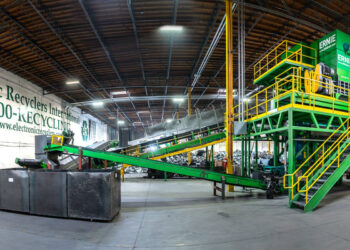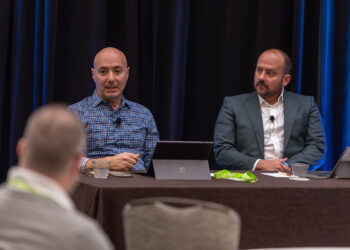A $2 million below-market loan from the Closed Loop Fund is helping a Nebraska company retrofit its materials recovery facility to better target PET and HDPE. The project is the latest such equipment improvement for First Star Recycling.
The Closed Loop Fund announced in January that it has invested in the Omaha-based company, which runs a single-stream MRF in the city.
In an interview, First Star Recycling CEO Dale Gubbels told Resource Recycling the project will address the “bottleneck” in the Omaha MRF, the container line. “It’s really bringing us into the 21st century in terms of our capabilities,” he said.
Container sorting improvements
The retrofit involves installing two optical sorters and bunkers that feed directly to an in-ground conveyor. New Hampshire-based Green Machine is supplying equipment for the project.
The optical sorters will target clear HDPE and PET. The in-ground conveyor will carry sorted recyclables directly to the baler, replacing the use of cages that have to be moved by forklift. Equipment installations will occur in March and April.
The project will yield both quantity and quality benefits on the container line. The line was first installed in 2005 and has relied mostly on hand sorting for plastics. Gubbels noted that the 2007 addition of plastics Nos. 3-7 overwhelmed the MRF container line, resulting in frequent stoppages. Currently capable of sorting about 1 ton per hour, the upgraded container line will tackle about 3 tons per hour, Gubbels said.
Gubbels noted the facility is still accepting 3-7 plastics, and although the market is “not terribly robust,” it’s sending mixed-plastic bales to the recently reopened ReVital Polymers plastics recycling facility (PRF) in Sarnia, Ontario.
Gubbels estimates the company is investing a total of about $2.4 million. That number includes the current retrofit and the installation of a ballistic separator last fall.
First Star Recycling’s bank was prepared to lend money for the project, but when Gubbels explained Closed Loop Fund’s loan terms, the banker “barely let me finish the sentence and said ‘If you don’t do it, you’re crazy.'”
Earlier changes
Last fall, Fiber Star Recycling replaced a star screen with a ballistic screen for the separation of two-dimensional materials from three-dimensional ones. That project was separate from the Closed Loop Fund loan.
“The ballistic screen has proven to be a much better approach for us to deal with separating the containers from the two-dimensional fiber,” he said. “It’s doing a great job on that.”
The company knew it needed to improve the fiber-container separation before it installed the optical sorters on the container line, Gubbels said. Otherwise, too much fiber would have been left on the belt at the optical sorters.
The Omaha MRF was also one of the first U.S. facilities to install a robot with artificial intelligence. In Nov. 2016, First Star Recycling installed a robot from Denver-based AMP Robotics. It was only the second U.S. MRF to introduce the advanced technology, after the Alpine Waste and Recycling Altogether Recycling MRF in the Denver area.
In Omaha, the robot is sorting clear HDPE. Gubbels suggested that after the retrofit is finished this spring, the robot might be moved to a quality-control function or a different location where it’s handling lower volumes.



























